A well-crafted resume is essential to landing any job, but if you’re applying for a job as a full-stack developer, then you’ve got a bit more work cut out for you. Full-stack developers can code both the frontend and backend of an application, so your resume needs to demonstrate your expertise with both. But, at the same time, your resume also needs to be concise. It’s a delicate balance and one that can be tricky to navigate.
That’s why we’ve created this guide. Below, we’ll tell you how to craft a stellar full-stack developer resume and show you some examples of what this looks like. Follow our advice, and all that’s left to do is nail the interview.
How Important Is a Full-Stack Developer Resume?
A well-crafted full-stack developer resume is absolutely essential to becoming a full-stack developer. Resumes show employers that you have the skills and expertise for the job at hand. So for full-stack developers, you’ll need your resume to demonstrate and evince both your frontend and backend skills. Additionally, you’ll want your resume to demonstrate that you understand the importance of having clean, well-structured code and that you know how to keep things organized for easy maintenance in the future.


Become a Software Engineer. Land a Job or Your Money Back.
Code in the industry's most widely used programming languages. Test your knowledge through job-ready projects. Work 1:1 with an industry mentor. Land a job — or your money back.
What Should You Include in Your Full-Stack Developer Resume?
Full-stack developer resumes should evince your expertise with both the backend and frontend of applications but without overwhelming a recruiter with information. You’ll also need to demonstrate that you have to know how to structure an application, that you understand how databases work, that can build interactivity, and that you can build an application that brings all this together seamlessly.
But how do you fit so much on your resume? Start by following these tips:
- Make it easy to read. Bullet points are a great way to organize your resume, and formatting your resume in this way will help you focus on what matters most.
- Keep it concise and focused. Cut the fluff and long-winded descriptions. Make sure that each section has enough relevant information without going overboard with filler words or unnecessary details.
- Include an objective or summary statement. Placing this at the top of your full-stack developer resume will give hiring managers an idea of who you are, and how you can contribute to their organization.
Here’s what you should include in your full-stack developer resume:
Your Name and Contact Information
Your name and contact information need to be visible on your resume, ideally at the top.
Education
Start by listing the most recent degree you’ve earned and work backward. Be sure to include any diplomas that are relevant to the position you’re applying for, such as a BA in Engineering or Web Development. And if you don’t think that you have the educational background to land a job as a full-stack developer, then consider enrolling in a software engineering bootcamp.
Relevant Skills
Make sure your resume includes your full-stack developer skills, both soft skills and hard skills. The hard skills are typically technical competencies that the employer has requested, and the soft skills are non-technical but still very important to the success of the job.
For example, if the job requires proficiency in Python, you’ll want to add it to your skill sets. The same goes for any programming languages or frameworks that are requested in the job description.
As a full-stack developer, you’ll be part of a software engineering team, so many sure that, under your soft skills, you mention your ability to communicate and multitask. (Furthermore, here is a post explaining what a software engineer really does.)
Relevant Certifications
Certifications are a stamp of approval that you have learned a specific skill and knowledge related to a certain field. So you’ll definitely want to include some of these on your full-stack developer resume. These can show employers that you’re up to date on the latest in technologies and practices.
Employment
As with your education, list your most recent work experience first, then work backward. And underneath each employer, list your role, responsibilities, and accomplishments. Make sure you spotlight your greatest achievements. You can also list the skills you’ve gained on the job, the projects you’ve worked on, and the KPIs you achieved with those projects.
Personal Projects
Personal projects can include anything from apps you’ve built to websites you’ve designed. This may seem like it’ll just get in the way and make your resume longer, but having a project on your resume that relates to the job you’re applying for can give you a leg up on the competition. And if you don’t have room for these on your resume, you can include them in your portfolio, which you can host online and link to from your resume.
Awards or Recognitions
By adding relevant awards to your resume, you can demonstrate your accomplishments and evince that you’re the most qualified candidate for the job.
For example, if you were recognized for a project via a press release or news article, include a link to that in your resume as proof of the award.
Get To Know Other Software Engineering Students
Abdelkareem ElSharief
Software Engineer at Bread
Alexander Aboutanos
Software Development Consultant at Sogeti
Moshood Adeyemo
Software Engineer at LinkedIn
Full-Stack Developer Resume Examples
Entry-Level Full-Stack Developer Resume
What to Include
While the number of years of experience you have is important for an entry-level position, companies are also looking for developers who can adapt quickly and learn new things. Having a solid foundation of core knowledge will help show that you can pick up new frameworks and technologies quickly.
To make yourself competitive, it’s beneficial to have some experience with web frameworks like Ruby on Rails and PHP.
Before you start writing your resume, think about these questions:
- What is your objective? Underscore how your previous extensive experience justifies your transition into a new role. Mention personal, academic, or professional projects or internships you were involved in that demonstrate your passion, technical skills, and resume-related interests.
- How does the job you are applying for differ from the jobs you have had in the past? Think about why you decided to switch jobs and what makes you qualified to transition to an entry-level full-stack developer role.
- What classes did you excel in? They may demonstrate that you have an in-depth knowledge of certain subjects. For example, you might be able to include your academic experience as an input for your entry-level full-stack developer resume because you did well in advanced computer science classes.
Include an objective or summary of qualifications that explains why you’re interested in this position and what makes you the best fit for it. Include concrete examples of how your previous experience and education qualify you for a job as an entry-level full-stack developer.
Entry-Level Full-Stack Developer Resume Example 1

We love this resume because it clearly states the candidate’s strengths and examples of how he has used them in his most recent roles. He also mentions collaborating with product managers to test systems, which tells us that he can understand what the product manager needs and implement it all while being aware of how the final product needs to function for the users and can adapt accordingly.
Entry-Level Full-Stack Developer Resume Example 2

This resume is an excellent example of the benefits of a well-rounded education.
Melania completed an online programming degree before applying for the job she’s now in, showing a high degree of adaptability along with her other skills.
She’s ready for new challenges as she’s demonstrated knowledge of JavaScript, HTML, and CSS, both crucial elements for an entry-level role.
Senior Full-Stack Developer Resume
What to Include
As a senior full-stack web developer, you will likely be responsible for a company’s entire front-end and back-end software development. Your role is to take an idea from the whiteboard and turn it into working code that is efficient and scalable.
Your resume should reflect your ability to work in an agile environment to build reusable code, libraries, and tools that enable rapid prototyping and delivery of features across multiple projects.
Here are some tips for making the most of your senior-level resume:
- Highlight your relevant experience.
- Be selective with your education. Less is more when it comes to education, especially if you graduated long ago.
- Keep it clean and simple—one page is fine for most jobs unless you have an extensive list of technology stacks or years of experience.
Senior Full-Stack Developer Resume Example 1
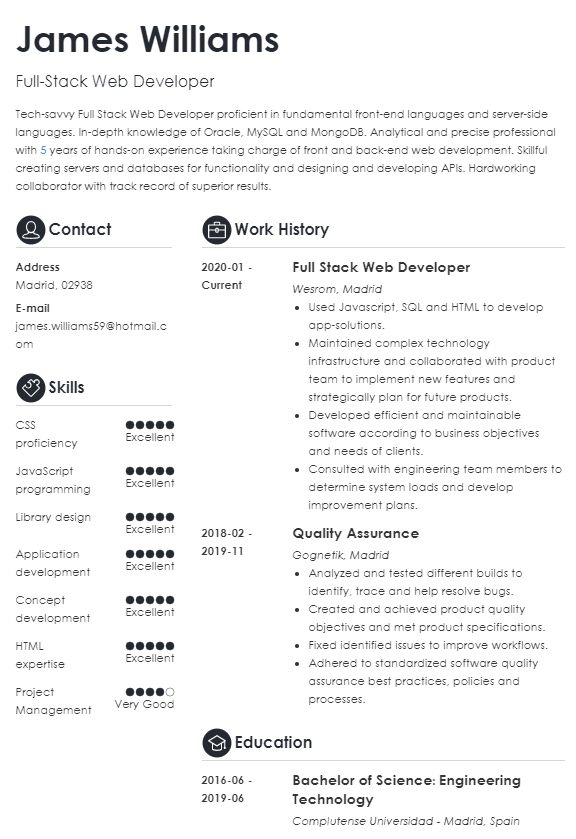
This resume demonstrates attention to detail and a sincere desire to stand out from the crowd.
The candidate puts his spin on his resume by arranging the skills in order of importance and showing off his programming skills and ability to manage projects.
Senior Full-Stack Developer Resume Example 2

This resume comes from a candidate whose extensive experience in the field matches the job description perfectly and who can demonstrate that they have the skills the employer is looking for.
It’s concise, with just enough detail to ensure you have all of the information you need to decide whether or not this candidate is right for your needs.
Java Full-Stack Developer Resume
What To Include
The first thing a hiring manager will see when going through your resume is your title.
When applying for a specialized role, like a Java full-stack developer, you must use the correct job title in your cover letter and resume. If you apply to a Java full-stack role, but the word “full-stack” is nowhere to be found in your cover letter or resume, it will be difficult for the HR representative to convince the hiring manager that you’re suitable for the role.
Recruiters look for specific keywords when searching resumes. They might search for Java or DevOps skills in the job description or overview, but they’ll also be skimming over the resumes looking for keywords. If you want to give them what they’re looking for and make yourself more qualified in their eyes, make sure the title on your resume matches their expectations.
Java Full-Stack Developer Resume Example 1
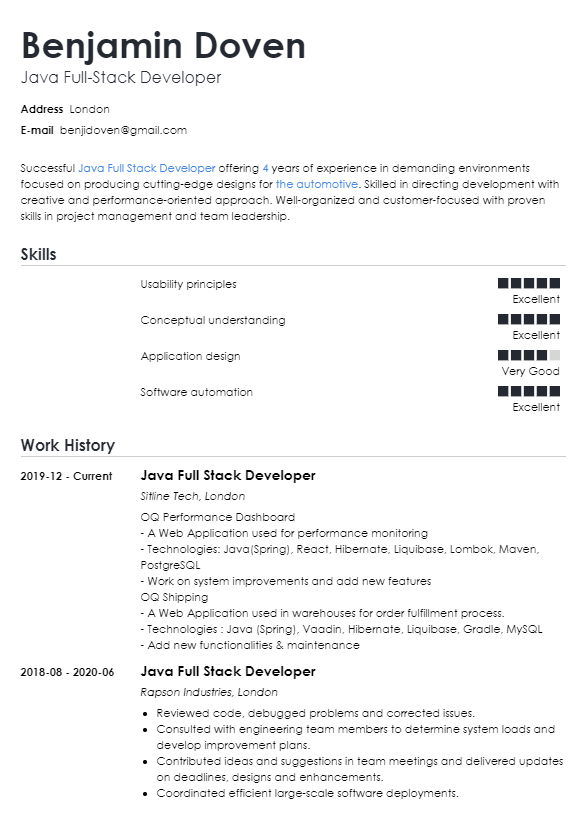
When it comes to having a great resume, you want the facts to speak for themselves. Benjamin’s resume is the perfect example of an excellent summary—he points out his role, years of experience, and industry.
This is particularly important for the employer to spot at a glance because they only have a couple of seconds before deciding whether or not to keep reading. Benjamin has tailored his resume to the company specifically by mentioning the industry. This is a good way to grab their attention with something they see as relevant before getting into your qualifications and experience.
Java Full-Stack Developer Resume Example 2

We love Adriana’s attention to detail when listing her full-stack developer skills and relevant info about her hands-on experience in past positions.
This is also great because Adriana has prior experience in this role, and she includes her relevant past jobs and how they relate to the position.
Other Full-Stack Developer Resumes We Like
Example 1
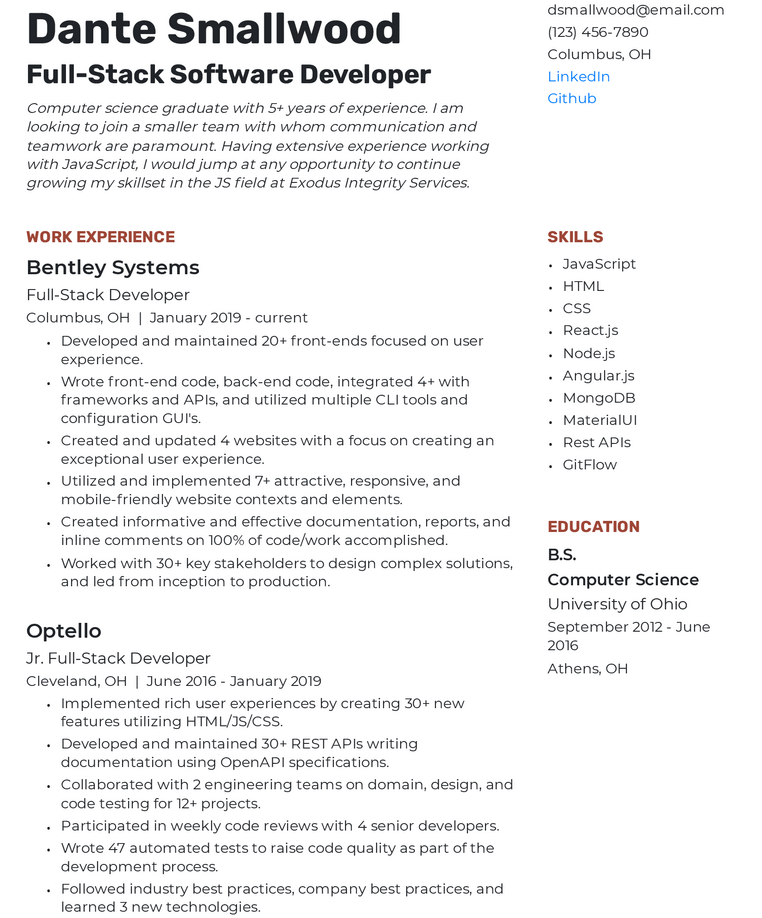
This resume is a great example of the skills section we would expect to see on a developer’s resume—it lists only the languages and frameworks that the candidate would be comfortable discussing in an interview.
Notice how this resume briefly lists the candidate’s education, which gives them more room to expand upon their work experience and skills.
Example 2

This senior developer resume demonstrates the skills Sarah gained over the years and her increasing level of responsibility throughout her career.
Using a reverse-chronological resume format will help to bring this out. A senior full-stack developer can potentially have a lot of responsibility on their shoulders, so quantifying the impact of the projects you’ve worked on is crucial.
Tips for Creating an Awesome Full Stack Developer Resume
How to Stand Out
There are certain things that can make your resume pop and increase your chances of getting called for that interview. These tips will help ensure that the hiring manager’s eyes light up when they see your resume.
Quantify Your Contributions
Statistics are a great way to evince your contributions. And this is true for full-stack developers at any stage of their career. For example, if you’ve managed an entire department, use statistics to describe its scope and size. Or, if you’re in a more junior role, you can show how you helped optimize your team’s output.
Determine the Indispensable Skills Your Resume Should Include
You should include front-end development skills such as proficiency in HTML, CSS, and JavaScript, but also back-end development skills like Java, Python, or C#.
If you have database management systems experience (like MySQL or Postgres), make sure to mention this too, as this is important for anyone working as a full-stack web developer.
Highlight a Project That Best Matches the Job Description
If you have any experience with a project that’s closely related to the job you’re applying for, make sure that you spotlight this. This shows that you’ve done your research about the company, and it demonstrates your knowledge of what the company is looking for. If a project fits well with the job description, it shows that you’ve taken the time to think about how you can contribute to what the company is doing.
Tailor Your Resume for Each Job
While it may seem easier to just send the same resume to all of the companies you’re applying to, you run the risk of sending a generic document that doesn’t address the specific needs of each company. When you tailor your resume specifically to each role, it shows that you’ve put time and effort into each application.
What To Avoid
Here are some common mistakes to avoid when creating your resume:
- Lying about your experience. Lying on your resume is never a good idea. All that does is risk getting caught and destroying your credibility.
- Being overly descriptive. Employers want to see what a candidate can achieve within the company in question—not that she can do everything under the sun. While they might appreciate all the details you include, they want to know how it will take them toward their goals.
- Include experience that’s irrelevant to the job description. It’s up to the candidate to ensure their expertise is relevant before applying for a job. It’s up to you to decide which aspects of your experience will help companies understand how well you’d fit into their company and which ones won’t help at all.
- Not including your GitHub portfolio or LinkedIn profile. Including your GitHub portfolio and LinkedIn profile is a great way to show off your work on projects big and small. You can even use it as an opportunity to demonstrate your coding skills by sharing projects that are relevant to the job you’re applying for.
Where To Find Full-Stack Developer Resume Templates
Zety

Zety is an online tool that helps you create a new resume or edit an existing one. With Zety, you can create a beautiful resume with no experience in design needed. We’ve tried the platform ourselves and it took less than 20 minutes to create a resume.
All you need to do is choose one of the available templates and fill in the blanks! The app lets you know if your resume is complete and professional enough—and gives you tips on making it better in real-time.
Beamjobs
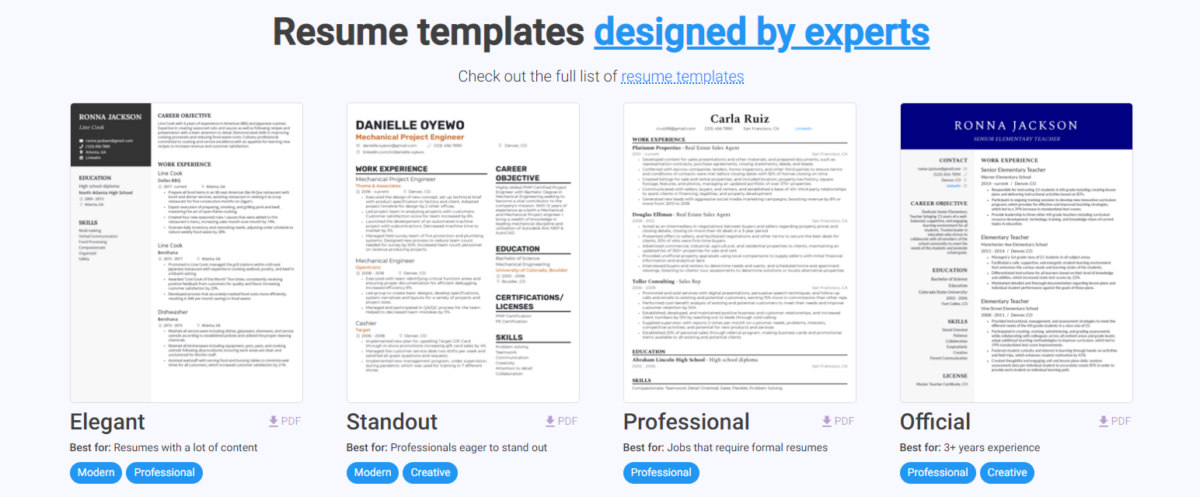
Beamjobs is another platform that lets you create a resume in just 12 minutes. It’s completely free, and it takes very little time to start using.
The results are impressive: their AI-powered resume checker gives you personalized tips for improving your resume based on the content you’ve already included. You can accept or reject any suggestions with the click of a button. This is a great way to learn how to make your resume more impressive before sharing it with potential employers.
EnhanceCV
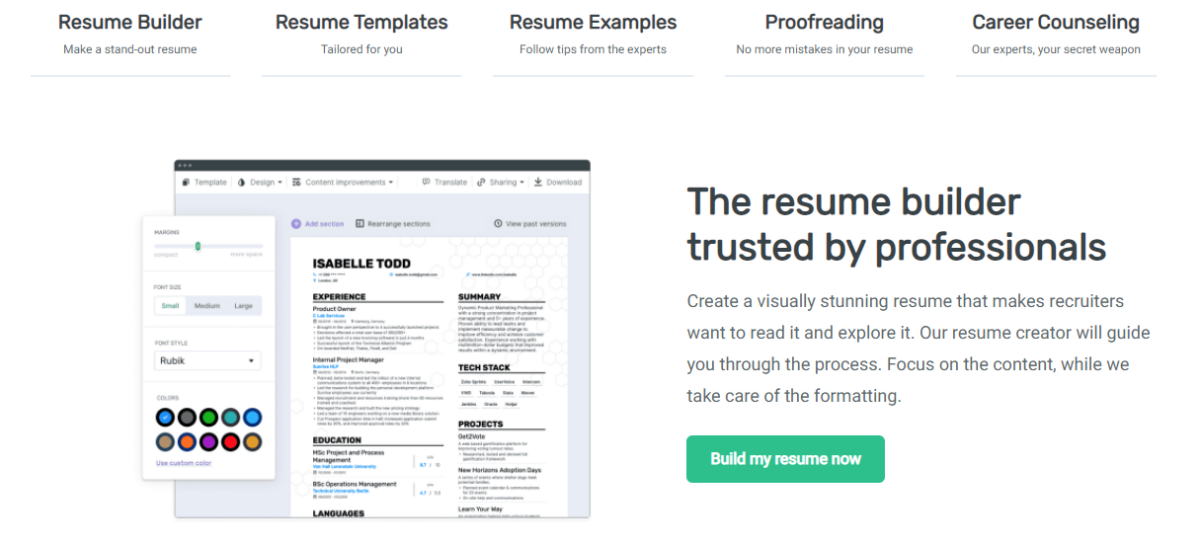
A well-formatted and visually appealing resume will help you win over the recruiters who decide whether or not you will be given an interview that could lead to your dream job.
But formatting a resume can be time-consuming, and it’s easy to make mistakes if you’re not used to it.
EnhanceCV allows you to create an online resume that looks as good as it reads. They guide you through selecting the right categories and adding content that is formatted in a way that makes recruiters want to read every word and explore your resume further.
Rezi

Rezi has created a way for anyone to improve their resume and chances of getting an interview.
It’s a web-based platform that quickly analyzes your resume and tells you exactly what keywords will improve your chances of being selected for an interview. You just enter your name and email address, and they pull your info from LinkedIn. Alternatively, you can also input your details into the forms and generate your resume.
And once you’ve been called in for an interview, check out our guide to full-stack developer interview questions.
Full-Stack Developer Resume FAQs
We’ve got the answers to your most frequently asked questions.
Do You Need to Customize Your Full-stack Developer Cv for Each Job?
It depends. If you’re applying for a job that requires a specific skill set, or if the company is looking for something specific, it might make sense to tweak your CV for each position.
We always suggest that people customize their resume for each position they’re applying for. Tailoring your resume not only shows that you’ve taken the time to learn about the organization you’re applying to. It also shows that you’ve paid attention to the job description and used that information to create a more effective application.
How Long Should Your Full-Stack Developer Resume Be?
The ideal length for a resume is one page—this allows for enough detail without being overwhelming or putting too much pressure on the employer or recruiter. A two-age resume is still acceptable, especially if you have extensive work experience.
Is a Resume the Same as Your Portfolio?
A resume is different from a portfolio, and you should ideally send both when applying for a job. While a resume summarizes the work you’ve done and your qualifications, a portfolio allows you to show potential employers examples of your work.
Since you’re here…
No one wakes up knowing how to code – they learn how to code. Tens of thousands of students have successfully learned with our courses, like our Software Engineering Bootcamp. If you’re a total newbie, our Software Engineering Career Track Prep Course will be a perfect fit. Let’s do this!






![How To Become a Software Engineer [2022 Career Guide]](https://www.springboard.com/blog/wp-content/uploads/2020/07/how-to-become-a-software-engineer-2022-career-guide.jpg)